- Animals and How They Affect Infant Health: An Underestimated Threat
- Animals and How They Affect Infant Health: Injuries and Infections
- Health Promotion Plan
- Accident Prevention and Health Promotion: Recommendations
- Examples, Interventions, and Suggestions from Research
- Community Resources
- National and Web-Based Resources
- References
Animals and How They Affect Infant Health: An Underestimated Threat
- Humans are surrounded by animals everywhere.
- Health concerns related to animals, especially pets, are sometimes underestimated.
- Nowadays, many people keep pets at home, which involves safety risks.
Many people love nature and regard contacting with the animal world as a practice that can lift one’s mood and help to forget about some problems. Animals surround us everywhere: in the street, in urban parks, during uptown trips, and at home as pets. Parents or caregivers of children younger than one year of age should address concerns associated with animals beforehand to prevent injuries and infections.
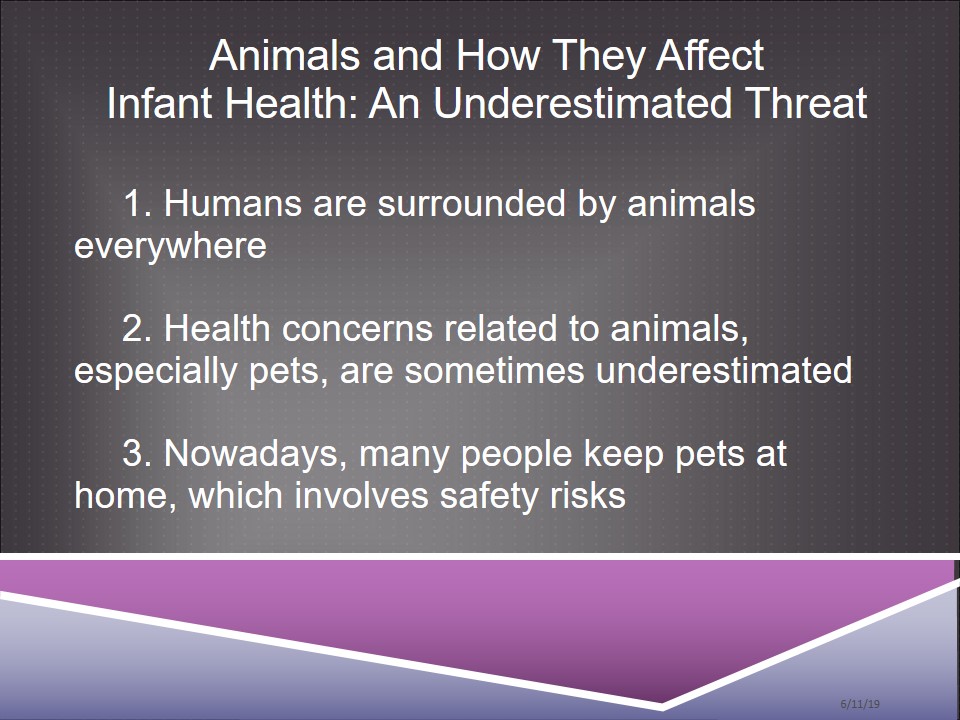
Animals and How They Affect Infant Health: Injuries and Infections
- There is a number of zoonotic diseases transmitted by animals.
- Their consequences are extremely dangerous for infants whose immune system is underdeveloped.
- Infants can be exposed to infection indirectly.
- Animals’ behavior may change unpredictably, which sometimes results in wounds in infants.
First of all, just like people, animals carry germs and spread infections that can sometimes be fatal even for adults, not to mention infants with their underdeveloped immune system. Both wild animals and pets can become the source of zoonotic diseases affecting infants’ health. Importantly, direct contacts with animals are not the only prerequisite to developing infections. The absence of proper hand hygiene in families keeping pets or farm animals can also contribute to risks. Secondly, all animals have specific ways of protecting themselves and do not always assess external threats in an accurate manner. Therefore, infant-animal interactions sometimes result in bites and scratches, causing different types of wounds.

Health Promotion Plan
- Increase the awareness of infants’ parents/caregivers of risks factors for animal bites.
- Improve the population’s understanding of hygiene practices reducing the risks of animal-borne diseases.
- Increase the knowledge of animal psychology and pet care to prevent misbehaviors (Centers for Disease Control and Prevention, 2019b; World Health Organization, 2018).
- Explain the principles of safe interactions between infants and pets.
The health promotion plan involves the provision of parent/caregiver education to reach three objectives. Firstly, the significance of the problem of animal bites and animal-related injuries is to be explained and placed in the context of other health risks for infants. Attention is to be paid to both wild and domestic animals and the key ways to prevent animal aggression. Secondly, the target population should be provided with substantial information on the risks of animal-transmitted infections resulting from injuries, poor hygiene, or direct contacts with animal waste or biological fluids.
The next two steps are more specific and are targeted at the subgroup keeping pets at home. According to the CDC (2019b) and WHO (2018), domestic cats’ and dogs’ aggression is among the common causes of animal bites. Pet owners who have infants should be aware of the causes of animal misbehavior, including lack of attention, emotional stress in pets, jealousy, disease, and other factors. Finally, they will receive recommendations on how to evaluate risks and ensure maximum safety for infants.
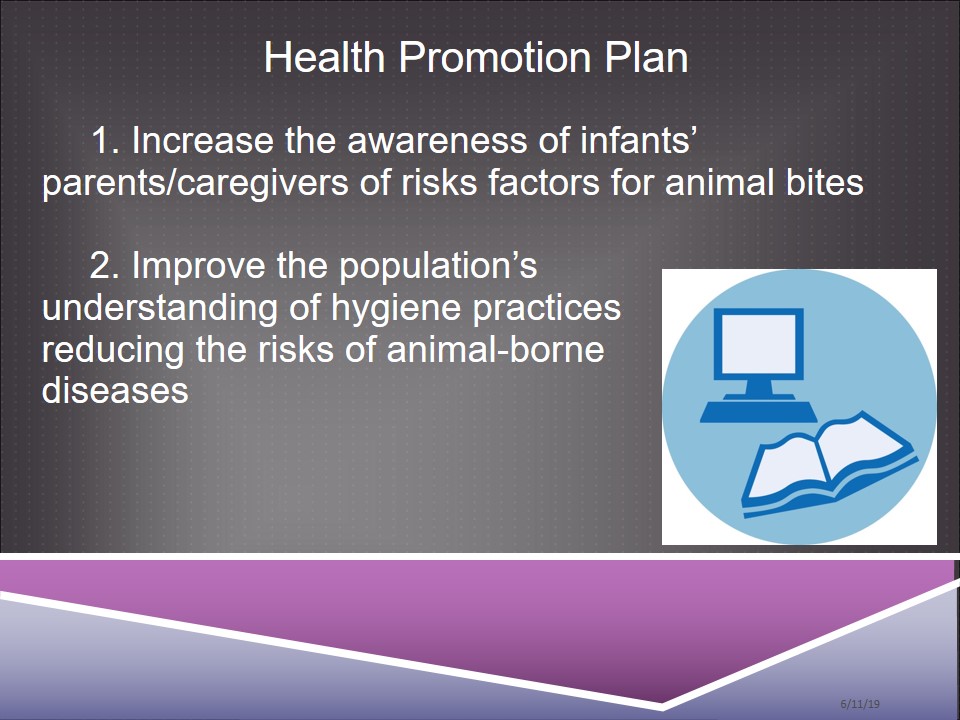
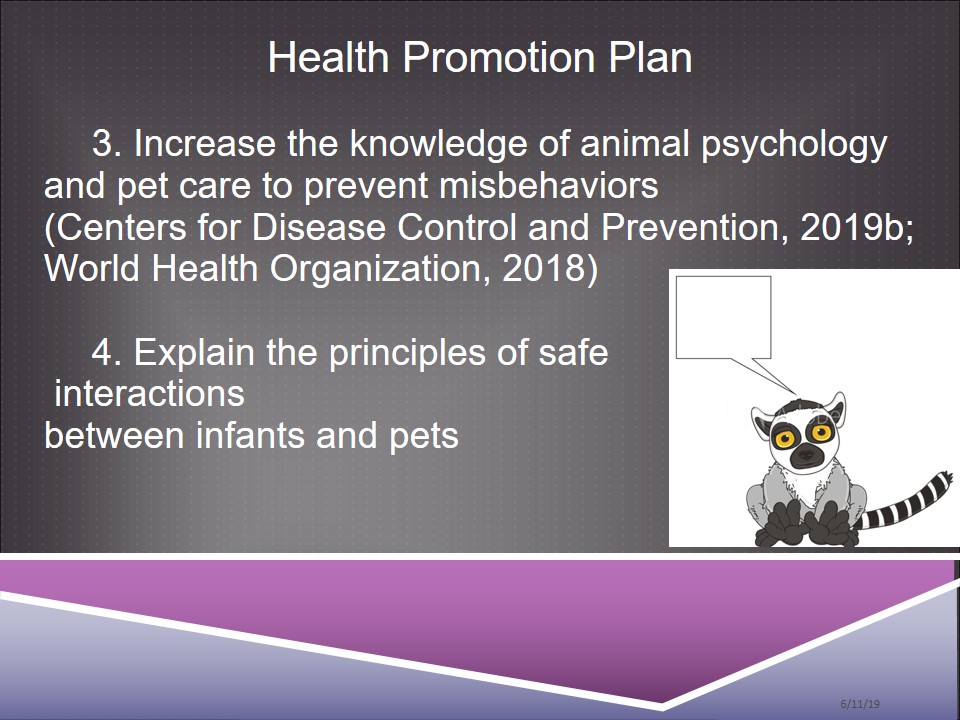
Accident Prevention and Health Promotion: Recommendations
- Infants should never be left alone with pets (CDC, 2019a).
- Before letting infants explore the environment, the presence of dangerous animals should be checked.
- Parents should not let stray animals approach infants and contact with such animals before touching their children.
- Parents and caregivers should check pets and farm animals for disease in a timely manner.
- The use of hygiene practices in both infants and adults after touching pets.
- Proper pet care to prevent aggressive behaviors (CDC, 2019b).
Even if family pets treat infants carefully and are friendly, parents and caregivers should not let them interact without supervision because animals can sometimes cause damage to infants unintentionally. Infants are naturally curious and want to explore the world, but potential risks are everywhere: there can be snakes in the grass or stray animals nearby. To prevent accidents, it is pivotal to assess risks and avoid contacts with unknown animals.
As for additional recommendations, pet owners are expected to pay close attention to their animals’ health and take measures in case of alarming symptoms to reduce health risks for an entire family, including infants. Even after playing with healthy pets, adults are expected to wash their infants’ and their own hands to avoid the transfer of bacteria living on animal hair and skin. Finally, pets can become extremely aggressive if they are mistreated or punished too often. With that in mind, parents or caregivers may need to analyze the quality of pet care that they provide to minimize the risks of jealousy and aggression toward infants.
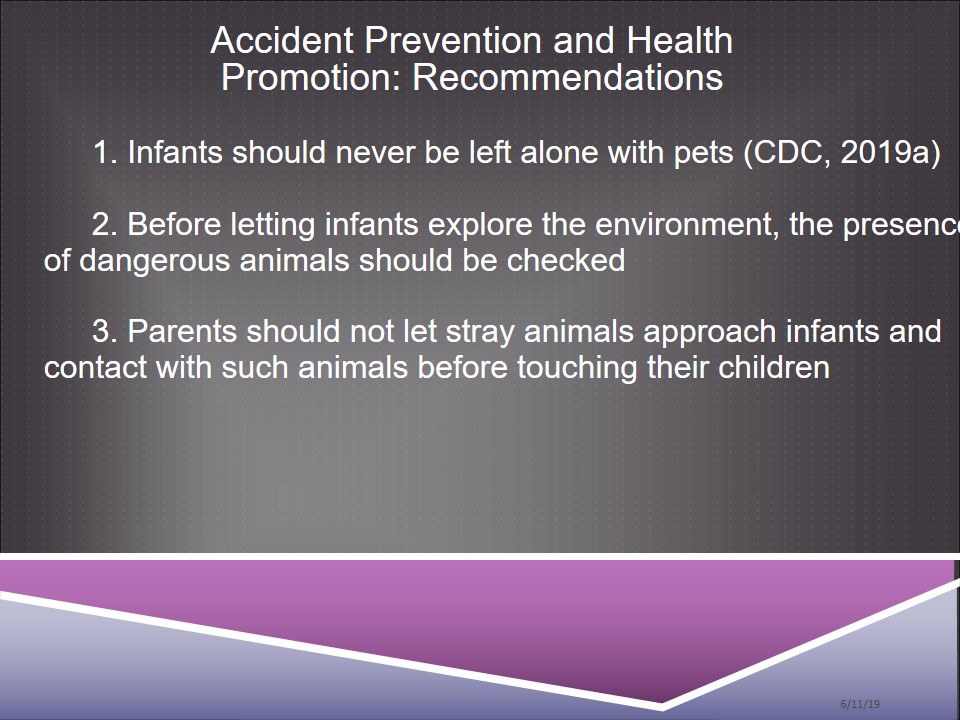
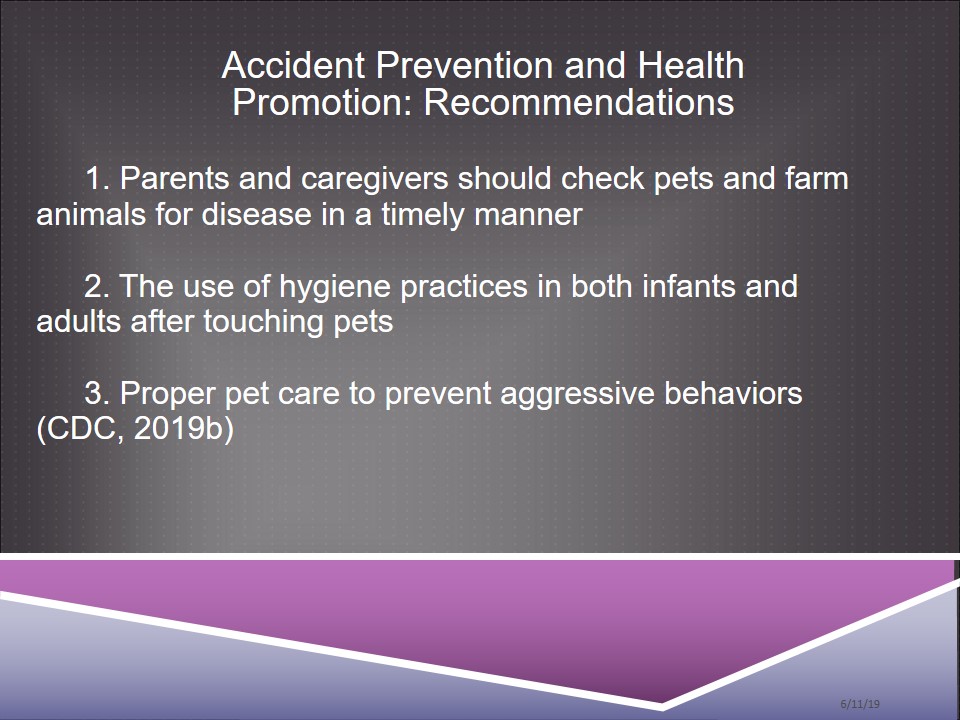
Examples, Interventions, and Suggestions from Research
- Intense tactile contacts are predictive of dog bites, so they are to be avoided (Owczarczak-Garstecka, Watkins, Christley, & Westgarth, 2018).
- Many animal bite injuries involve face wounds, so infants and children should be prevented from kissing animals (Agrawal, Kumar, Singhal, Singh, & Bhagol, 2017).
- Particular hand hygiene strategies during and after disposing of pet feces (gloves, cleaning products) are critical to family health (Nelson, Saha, & Mead, 2016).
- Less than 50% of people who keep pets at home consult veterinarians to reduce risks for their children (Russo, Vergnano, Bergero, & Prola, 2017).
- Pets are to be vaccinated against rabies and other diseases to reduce risks for infants and older children (Gharpure, Mitchell, Dolan, Iverson, & Feldman, 2019).
As is clear from modern scholarly research, to prevent animal bites, prolonged and intense tactile contacts between pets and infants should be prevented. Proper supervision is even more important when it comes to interactions involving the infant’s face. Also, apart from washing hands, parents or caregivers should use a variety of cleaning supplies to care for pets without causing harm to infants.
The need for focused educational interventions for parents and caregivers is not overestimated. For example, according to the study by Russo et al. (2017), many parents of infants think that they fully understand health risks related to pets, but less than half of them consult veterinarians or other specialists to address potential concerns. In particular, pet owners who have children are to be educated on timely pet vaccinations and its significance to infants’ health.
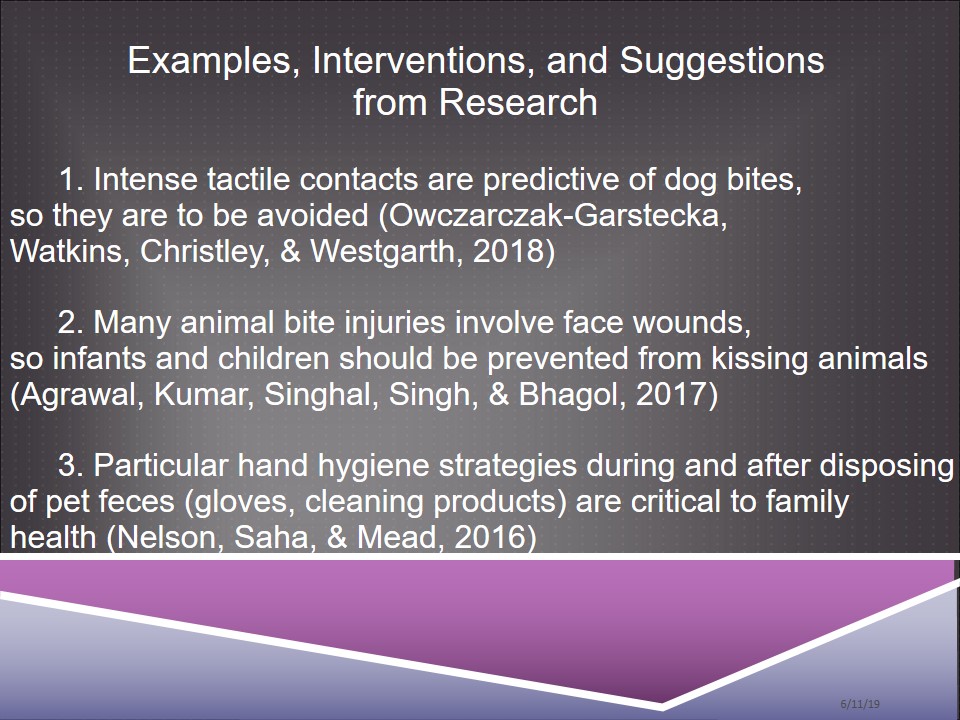
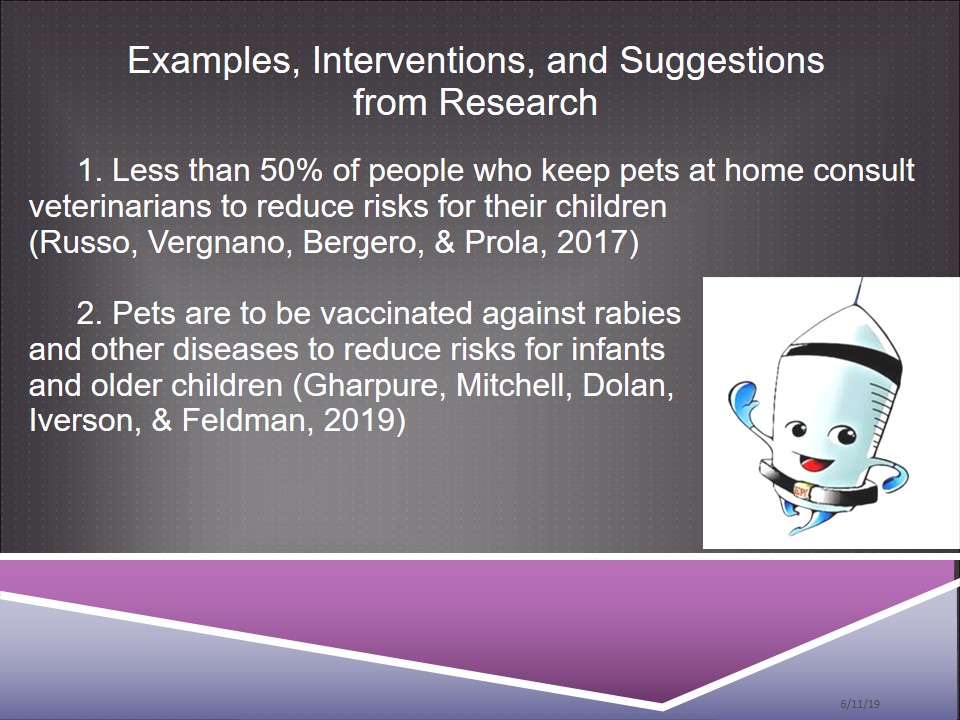
Community Resources
- California Department of Public Health. Address: PO box 997377, MS 0500. Sacramento, CA. Phone number: (916) 558-1784.
- Veterinary Behavior Consultants. Address: 5040 Convoy St., San Diego, CA 92111. Phone number: (858) 259-6115.
The first community resource that parents can refer to in case of questions is the California Department of Public Health. The resource can be accessed to learn more about the current spread of animal-borne disease, infant immunization, or similar topics.
Next, in case of specific concerns related to pet-infant interactions, parents may need to contact specialists in animal psychology from the Veterinary Behavior Consultants and get focused help.
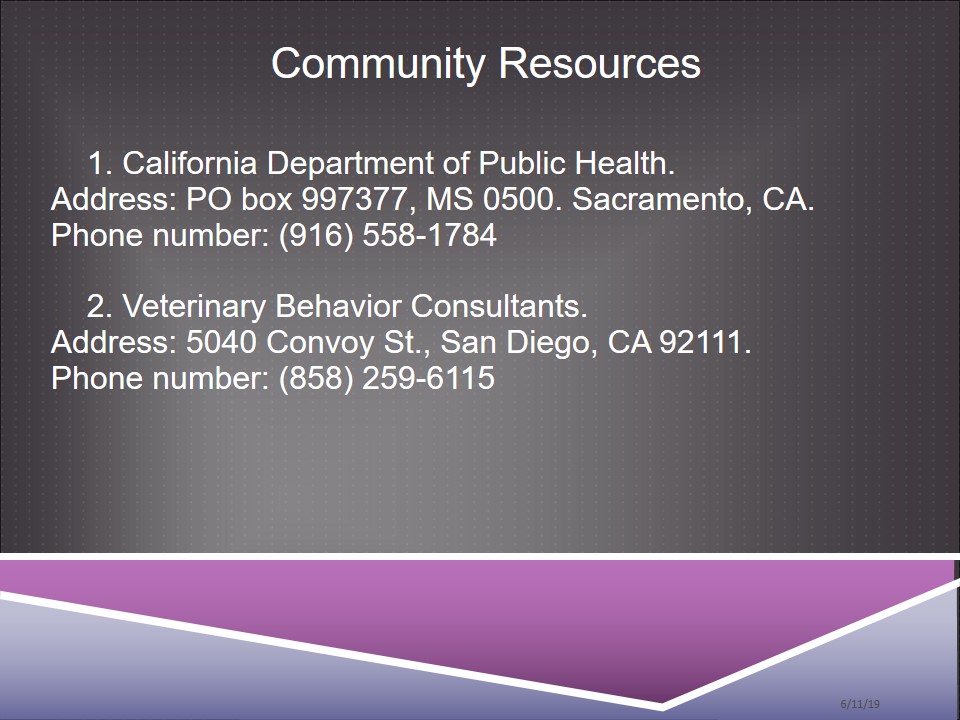
National and Web-Based Resources
- The National Child Safety Council. Address: P.O. Box 1368 Jackson, MI 49204-1368. Phone number: 1-800-327-5107.
- Healthychildren. Web.
The National Child Safety Council is a non-profit organization concerned with the health of infants and children, this resource can be used to get valuable recommendations or get acquainted with safety topics related to animals. Next, on healthychildren.org, parents and caregivers can consult pediatricians to ask questions about infant safety and animal bite prevention.
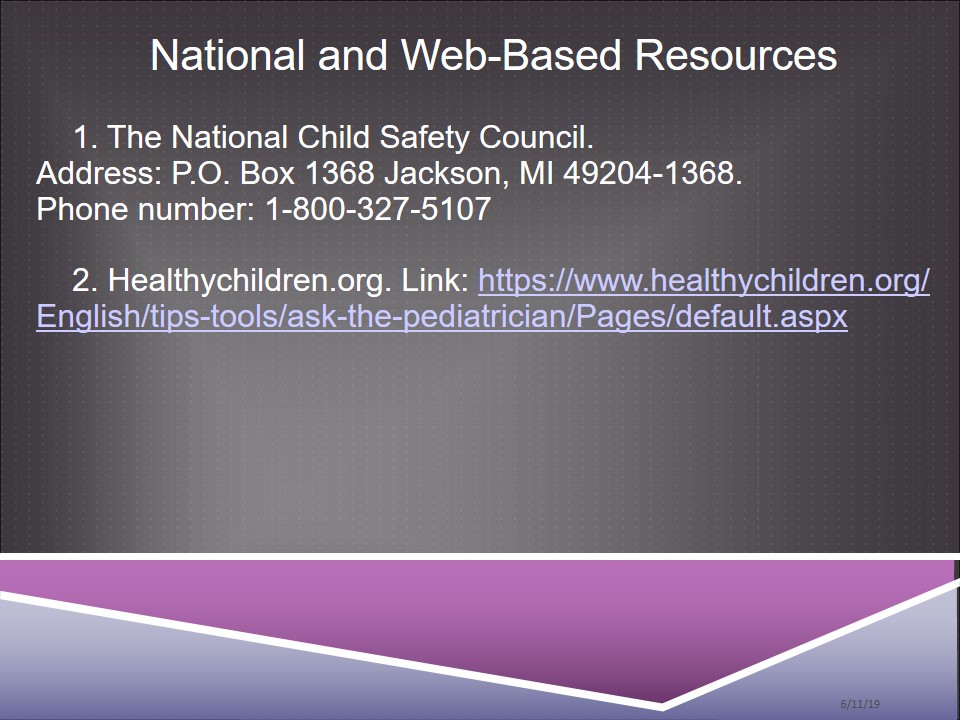
References
Agrawal, A., Kumar, P., Singhal, R., Singh, V., & Bhagol, A. (2017). Animal bite injuries in children: Review of literature and case series. International Journal of Clinical Pediatric Dentistry, 10(1), 67-72. Web.
Centers for Disease Control and Prevention. (2019a). Infants and young children: How to keep children healthy around animals. Web.
Centers for Disease Control and Prevention. (2019b). Preventing dog bites. Web.
Gharpure, R., Mitchell, K. C., Dolan, S., Iverson, S. A., & Feldman, K. A. (2019). Low-cost animal rabies vaccination clinics in Maryland facilitate access to rabies vaccination for pets. Vector-Borne and Zoonotic Diseases, 19(5), 370-377. Web.
Nelson, C. A., Saha, S., & Mead, P. S. (2016). Cat-scratch disease in the United States, 2005–2013. Emerging Infectious Diseases, 22(10), 1741-1746. Web.
Owczarczak-Garstecka, S. C., Watkins, F., Christley, R., & Westgarth, C. (2018). Online videos indicate human and dog behaviour preceding dog bites and the context in which bites occur. Scientific Reports, 8, 1-11. Web.
Russo, N., Vergnano, D., Bergero, D., & Prola, L. (2017). Small pilot survey on parents’ perception of the relationship between children and pets. Veterinary Sciences, 4(4), 1-5. Web.
World Health Organization. (2018). Animal bites. Web.